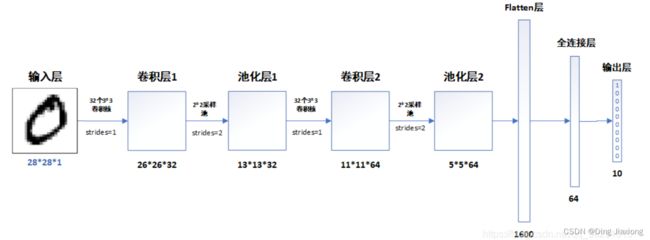深度学习100例 —— 卷积神经网络(CNN)实现mnist手写数字识别
活动地址:CSDN21天学习挑战赛
深度学习100例 —— 卷积神经网络(CNN)实现mnist手写数字识别
K老师用的tensorflow框架,啊这,新一个虚拟环境吧。
Python:3.7
编译器:jupyter notebook
深度学习框架:TensorFlow2.7.0
1. 前期准备工作
1.1 设置GPU
这里最后我还是选择了用AutoDL的算力,不舍得在自己电脑上跑。
import tensorflow as tf
gpus = tf.config.list_physical_devices("GPU") # tf.config.list_physical_devices# 获得当前主机上某种特定运算设备类型(如 GPU 或 CPU )的列表
if gpus:
gpu0 = gpus[0] #如果有多个GPU,仅使用第0个GPU
tf.config.experimental.set_memory_growth(gpu0, True) #设置GPU显存用量按需使用
tf.config.set_visible_devices([gpu0],"GPU") # 设置可见设备列表
1.2 导入数据
import tensorflow as tf
from tensorflow.keras import datasets, layers, models
import matplotlib.pyplot as plt
(train_images, train_labels), (test_images, test_labels) = datasets.mnist.load_data()
MNIST手写数字数据集来源于是美国国家标准与技术研究所,是著名的公开数据集之一。数据集中的数字图片是由250个不同职业的人纯手写绘制。
MNIST手写数字数据集中包含了70000张图片,其中60000张为训练数据,10000张为测试数据,70000张图片均是28*28
28 x 28 像素转换为向量,得到长度为28 x 28 = 784 的向量,
1.3 数据归一化处理
作用:
- 使不同量纲的特征处于同一数值量级,减少方差大的特征的影响,使模型更准确。
- 加快学习算法的收敛速度。
归一化:把数变为(0 , 1)之间的小数;缩放仅仅跟最大值、最小值的差别有关。
# 将像素的值标准化至0到1的区间内。
train_images, test_images = train_images / 255.0, test_images / 255.0
train_images.shape,test_images.shape,train_labels.shape,test_labels.shape
1.4 可视化图片
plt.figure(figsize=(20,10)) # 设置绘图窗口大小
for i in range(20):
plt.subplot(5,10,i+1) # 整个figure被分为5行10列,从左到右,从上到下编号为1,2,3...
plt.xticks([]) # 绘制x轴标签的方向
plt.yticks([]) # 绘制y轴标签的方向
plt.grid(False) # 关闭网格线显示
plt.imshow(train_images[i], cmap=plt.cm.binary) # cmap=plt.cm.binary → 显示黑白图像,展示0-19的图像
plt.xlabel(train_labels[i]) # 设置x轴标签为对应的标签值
plt.show()
1.5 调整图片格式
#调整数据到我们需要的格式
train_images = train_images.reshape((60000, 28, 28, 1))
test_images = test_images.reshape((10000, 28, 28, 1))
train_images.shape,test_images.shape,train_labels.shape,test_labels.shape
→ 数据维度转换,增加通道维度
2. 构建CNN网络模型
2.1 构建网络
model = models.Sequential(
[
layers.Conv2D(32 , (3 , 3) , activation = 'relu', input_shape = [28 , 28 , 1]), # 卷积层1,卷积核3 x 3
layers.MaxPooling2D((2, 2)), # 池化层1 , 2 x 2 采样
layers.Conv2D(64 , (3 , 3) , activation = 'relu'), # 卷积层2 , 卷积核3 x 3
layers.MaxPooling2D((2, 2)), # 池化层2, 2 x 2 采样
layers.Flatten(), # Flatten层,连接卷积层与全连接层
layers.Dense(64 , activation = 'relu'), # 全连接层,特征进一步提取
layers.Dense(10) # 输出层,输出结果
]
)
model.summary()
网络结构
2.2 模型结构说明:
各层的作用:
- 输入层:将数据输入到训练网络
- 卷积层:使用卷积核提取图片的特征
- 池化层:进行下采样,用更高层的抽象表示图像特征
- Flatten层:将多维的输入一维化,常用在卷积层到全连接层的过渡
- 全连接层:特征提取器
- 输出层:输出结果
3. 编译模型
model.compile(optimizer='adam',
loss=tf.keras.losses.SparseCategoricalCrossentropy(from_logits=True),
metrics=['accuracy'])
compile()方法用于设置训练时,使用的优化器optimizer、损失函数loss、准确率评测标准metrics
SparseCategoricalCrossentropy → 交叉熵损失函数,当from_logits参数为True时,会使用softmax将预测y转换为概率。
4. 训练模型
history = model.fit(train_images, train_labels, epochs=10,
validation_data=(test_images, test_labels))
epoch : 迭代次数,全部样本将会被训练循环10次
validation_data:指定验证数据。
编译模型设置的准确率,这里即输出准确率
5. 预测
看看测试集中的0号图片
OK,是个7
使用训练好的模型进行预测:












